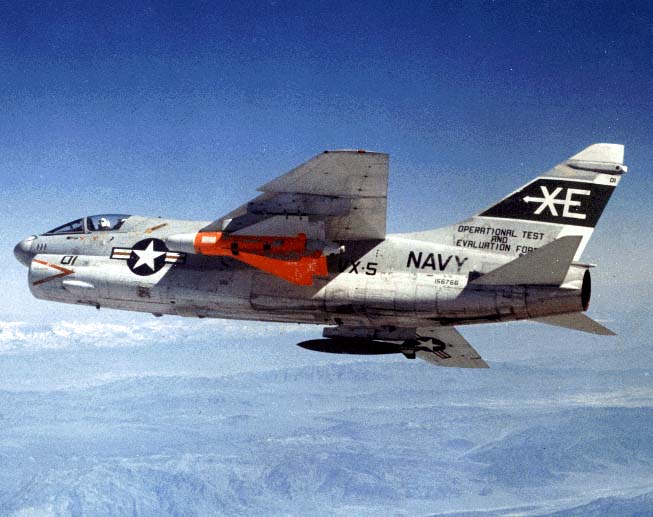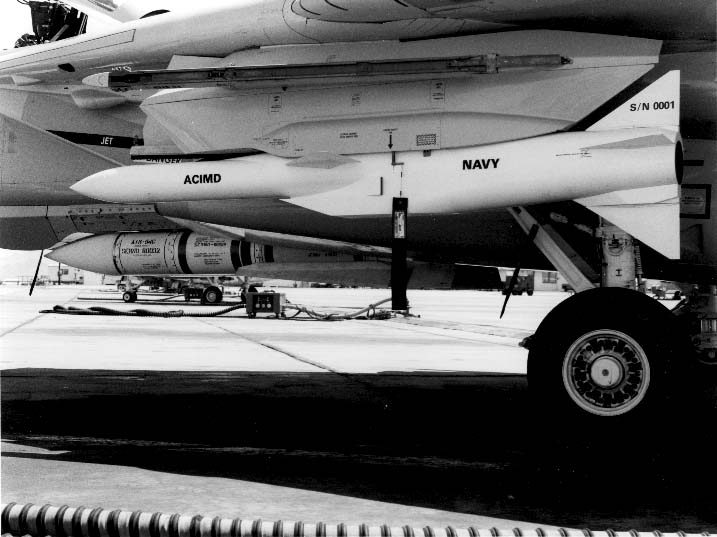ROCKETS
Aircraft rockets were China Lake's raison d'etre at its establishment. The early forward-firing aircraft rockets developed by the CalTech-NOTS team included the 3.5- and 5.0-Inch Aircraft Rockets; the 5.0-Inch High-Velocity Aircraft Rocket, Holy Moses; and the 11.75-inch Tiny Tim. Early China Lake products also included spin-stabilized bombardment rockets and special-purpose rockets that were used for everything from propelling line charges to sampling atomic clouds. Folding-fin aircraft rockets (FFARs) are another highly successful China Lake product; literally millions of the 2.75-inch Mighty Mouse and 5.0-inch Zuni have been fired in combat. Related work by China Lake includes the development of the BOMROC system and several rocket-assisted projectiles (RAPs); work on RAPs evolved over the years to include extended-range guided projectiles, such as the Antiradiation Projectile (ARP). China Lake's rocketry expertise--propulsion, warheads, airframes, aerodynamics, ballistics, launchers, fire-control, etc.--was also instrumental in establishing its guided missile programs.
"Mighty Mouse" 2.75-Inch Folding-Fin Aircraft Rocket (FFAR); originally conceived as an air-to-air weapon, and first used in combat in the Korean War, the 2.75 (with its expendable pod launchers) became the standard ground-attack rocket.
Tiny Tim 11.75-Inch Aircraft Rocket firing from SB2C aircraft; designed by the CalTech-China Lake team as a bunker-buster, Tim was the first large aircraft rocket, and, although it saw only limited service in WWII, it helped form the foundations of many postwar developments in rocketry.
FREE-FALL WEAPONS
Snakeye was fielded in 1964 and used extensively since; the retarder tail (Mk 14/Mk 15 fins for Mk 81 250-pound/Mk 82 500-pound bombs) allowed low-level, high-precision attack while avoiding bomb-fragment damage to delivery aircraft and retaining a low-drag delivery option.
FAE II test detonation near target ship ex-U.S.S. McNulty . Second-generation FAE weapons were developed from the FAE I type devices (CBU-55/72) used in Vietnam.
Rockeye II (antitank cluster bomb Mk 20), dropped from an A-4 Skyhawk, immediately after opening; fielded in 1968 and still in service, Rockeye dispenses 247 shaped-charge antitank bomblets; the dispenser is also used in the Gator air-delivered mine system.
The "Eye" Series of free-fall weapons (originally targeted with an "iron bombsite and a Mk 1 eyeball") began with a late-'50s China Lake study that showed the need for improved conventional weapons. NOTS developed a family of weapons during the 1960s that included the well-known Snakeye fin-retarded bomb (Mk 81 and Mk 82 GP bombs) and the Rockeye II antitank/material cluster weapon Mk 20, which has provided the basis for other dispenser weapons such as the current Gator mine-delivery system. The Eye series also included the Sadeye, Rockeye I, and Gladeye dispenser weapons; Fireye gelled-fuel weapon; Briteye balloon-borne flare; and Deneye antitank mine-dispenser system--as well as some special-purpose weapons, submunitions, fuzes, launchers, and supporting systems. Follow-on work included design and development for the Advanced Bomb Family.
China Lake also developed and applied the technology of Fuel-Air Explosive (FAE) Weapons, from grenades to 2,000-pound FAE II bombs (BLU-96/B). FAE I (CBU-55/72) was deployed in 1970, and further developments have included surface-launched mine-clearing systems (SLU-FAE and CATFAE)
GUIDED MISSILES
Developmental Agile (XAIM-95) thrust-vector-controlled, multimode-guided, advanced dogfight missile; Agile, an outgrowth of NWC technology initiatives, demonstrated 55-g, 118-degree angle-of-attack maneuvering before the program was terminated.
Sidewinder AIM-9M meets full-scale aircraft target over China Lake ranges; the Station developed a variety of targets for Sidewinder T&E and training (and for general target use), including aircraft (e.g., QF-86, QF-4) and specialized rockets.
Nearly every guided missile in the U.S. Inventory today owes a major debt to China Lake R&D efforts in sensors, guidance, control, fuzing, propulsion, warheads, and materials technology. China Lake has made significant contributions to every aspect of guided missile technology and development.
Harpoon missile seeker in one of the hardware-in-the-loop simulation laboratories; China Lake has carried on extensive product-improvement and production- and Fleet-support programs for weapons such as Harpoon, Sparrow, Maverick, and Tomahawk.
A-7 Corsair of tenant OPTEVFOR squadron VX-5 carrying Walleye II (AGM-62) ERDL (extended-range data link); the Walleye TV-guided glide weapon provides outstanding accuracy, and its 2,000-pound linear-shaped-charge warhead is a match for almost any target.
Sidewinder is certainly China Lake's best-known success, although far from being its only one. Although guided missiles were originally outside of the Station's charter, Sidewinder was developed by China Lake beginning with a 1949 feasibility study that begat the "heat-homing rocket" that became Sidewinder. Fielded in 1956 and combat proven in 1958, AIM-9A through AIM-9M versions of the deadly little heat-seeker have served the Fleet for over 35 years. Developed and modernized with the principles of simplicity, reliability, and producibility in mind, the AIM-9 family of missiles has proven to be the world's most accurate, reliable, and successful dogfight missile--a missile adopted and copied by friend and foe alike. During the '70s NWC pursued Agile (XAIM-95), an advanced dogfight missile combining China Lake technology advancements in thrust-vector control, guidance, and targeting. China Lake demonstrated the technology and hardware for the next-generation long-range air-to-air missile with its Advanced Common Intercept Missile Demonstration (ACIMD), which incorporated advanced guidance, ramjet-propulsion, warhead, and airframe technologies.
The "Heat-Homing Rocket": developmental Sidewinders mounted for test flight; guided missiles, per se, were specifically excluded from the Station's charter at one time.
Advanced Common Intercept Missile Demonstration (ACIMD) fit- test on F-14; the goal of China Lake's ACIMD was a long-range, highly capable, but smaller (Sparrow-sized) Phoenix follow-on for the outer-air-battle role; ACIMD incorporated advanced multimode-guidance, integral-rocket-ramjet propulsion, warhead/fuzing, and airframe/steering technologies--primarily China Lake developed.
Shrike (AGM-45) is another China Lake development demanded directly by the Fleet; the first successful antiradar missile, Shrike has become one of the most-fired guided missiles in history since its 1965 combat debut. Along with Shrike developments, China Lake antiradar technology programs (such as ERASE and its products and by-products, like the Antiradiation Projectile) provided the foundations for the next generation of antiradar missiles, including HARM (AGM-88). With the Walleye (AGM-62) TV-guided glide bomb, China Lake designed and developed the first precision-guided antisurface weapon. An outgrowth of in-house technology efforts, Walleye was fielded in 1967 and proved its unsurpassed accuracy in combat. Related to Walleye but cancelled before completion was Condor (AGM-53), a rocket-powered TV-guided missile. Extended-range data links have also been developed for Walleye. China Lake also developed Bulldog (AGM-83), the first successful laser-guided missile, which was approved for service use in 1974 but cancelled in favor of the Air Force Maverick.
A-4C Skyhawk firing AGM-45 Shrike antiradar missile on China Lake range; Shrike was developed following many of the same principles that guided Sidewinder development: simplicity, reliability, maintainability, producibility, improvability.
Missile improvement and support projects have been conducted by China Lake for a variety of Navy missile systems, notably Sparrow (AIM/RIM-7), Maverick (AGM-65), Harpoon (A/R/UGM-84), and Tomahawk (BGM-109). China Lake provided the engineering, documentation, and production disciplines to get these programs back on track when they ran into trouble and followed support efforts with improvement projects for components and systems.
ANTISUBMARINE WEAPONS
Antisubmarine warfare (ASW) was at one time a major area of endeavor for NOTS; the Pasadena Annex was the focus of ASW work, which included technology development, submarine-detection systems, torpedoes, fire control, and delivery systems. China Lake and Pasadena developed a variety of ASW rockets, including the 12.75-inch "Weapon A" rocket-propelled depth bomb and launcher system; the Rocket-Assisted Torpedo (RAT); and ASROC, which superseded RAT and went to the Fleet in 1960. ASROC versions are still in service, including Vertical-Launch ASROC.
Vertical-Launch ASROC test firing at China Lake; NOTS (China Lake and Pasadena) developed ASROC during the 1950s, and it became a standard Fleet ASW system during the early '60s; the vertical-launch variant is compatible with the Navy's newest ships.
"SWISH" torpedo-hydrodynamics test vehicle surfacing in 1959 test; NOTS torpedo work was centered at the Pasadena Annex and included basic and applied research in related fields and ASW concepts; development of sub-, ship-, rocket-, and air-launched torpedoes, launchers, and components; and development and support of remote-controlled and manned submersibles.
NOTS Pasadena developed or participated in the development of the Mk 32 Mod 2, Mk 42, Mk 43, Mk 44, and Mk 46 torpedoes. NOTS also developed devices like the Mk 40 Torpedo Test Vehicle for RDT&E, and programs such as Project SWISH studies of torpedo hydrodynamic noise and RETORC--the Research Torpedo Configuration--laid the groundwork for further developments in ASW weapons, including the Mk 48 torpedo.
SPECIAL WEAPONS
China Lake work on special weapons--nuclear weapons--began with Project Camel, part of the Manhattan Project, to develop and produce non-nuclear explosive bomb components (for which the Salt Wells Pilot Plant was built) and test bomb shapes. China Lake did not work on nuclear warheads, but supported a number of special weapon programs during the 1950s, when the military's focus was largely on nuclear weapons, with safety evaluations, component and shape testing, and component development. China Lake redesigned the Elsie (TX 8/TX 11) penetrator weapon and developed the Bombardment Aircraft Rocket (BOAR), one of the earliest rockets designed to carry a nuclear warhead. NOTS also demonstrated in 1957 a submarine-launched bombardment missile called Marlin.
Test firing of 30.5-Inch Bombardment Aircraft Rocket (BOAR), sans warhead, 1955; one of the earliest rockets designed to carry a nuclear warhead (Mk 7), BOAR was developed by NOTS as an interim weapon with a planned service use of 3 years, but the 30.5-Inch Rocket Mk 1 was deployed in 1956 and remained in the Fleet until 1963.
Polaris test round recovery by the "Fishhook" barge at China Lake's San Clemente Island facility; part of Operation Pop-Up, Fishhook caught the submerged-launch-test round at apogee, preventing fallback damage; China Lake also did rocket motor T&E and helped shape the original concept of the Polaris system.
One of China Lake's most significant areas of accomplishment is in Fleet ballistic missile support, especially with regard to Polaris. The Polaris Studies conducted by China Lake were instrumental in the development of the concept and the weapon system, and China Lake played a crucial role in rocket motor testing (Skytop) and underwater-launch testing (Pop-Up). The T&E role continues to be significant, as witnessed by the huge Trident II motor test facilities opened in 1986.
Packing a "Fat Man" test shape at China Lake Salt Wells Pilot Plant, a highly secret facility of the Manhattan Project; bomb-shape drops and explosives and explosive-lens development and production were part of Project Camel at NOTS; Salt Wells' relationship to the A-Bomb project and, later, to the AEC, remained secret for decades thereafter.


















